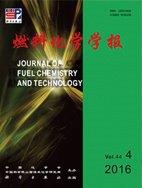2025 Volume 53 Issue 3
2025, 53(3): 348-359
doi: 10.1016/S1872-5813(24)60514-1
Abstract:
By adjusting the pH value of the precursor solution, different morphologies of BiVO4:Yb3+,Er3+-X (BYE-X) were successfully synthesized via a facile microwave hydrothermal method. Tetracycline was employed as a model pollutant to evaluate the full-spectrum photocatalytic activity of BYE-X samples. The experimental results revealed that when the pH ranged from 3 to 8, BYE showed pure monoclinic BiVO4 phase. At pH values of 10−12, the synthesized samples had mixed phases of Bi2O(OH)(VO4), Bi2O3, and BiVO4. A notable variation in the morphological characteristics of BYE was observed with the increasing pH values. The samples of different pH values showed obvious up-conversion luminescence. Due to the up-conversion of Er3+ and Yb3+, the near-infrared (NIR) light was effectively utilized, successfully broadening the light response range. Under the visible or NIR light irradiation, BYE-5 demonstrated the optimal photodegradation activity. Based on the experimental results, a mechanism for full-spectrum photocatalysis was proposed. This work provides a feasible approach to improving the utilization of solar light by semiconductor catalysts, thereby achieving efficient full-spectrum photocatalytic activity.
By adjusting the pH value of the precursor solution, different morphologies of BiVO4:Yb3+,Er3+-X (BYE-X) were successfully synthesized via a facile microwave hydrothermal method. Tetracycline was employed as a model pollutant to evaluate the full-spectrum photocatalytic activity of BYE-X samples. The experimental results revealed that when the pH ranged from 3 to 8, BYE showed pure monoclinic BiVO4 phase. At pH values of 10−12, the synthesized samples had mixed phases of Bi2O(OH)(VO4), Bi2O3, and BiVO4. A notable variation in the morphological characteristics of BYE was observed with the increasing pH values. The samples of different pH values showed obvious up-conversion luminescence. Due to the up-conversion of Er3+ and Yb3+, the near-infrared (NIR) light was effectively utilized, successfully broadening the light response range. Under the visible or NIR light irradiation, BYE-5 demonstrated the optimal photodegradation activity. Based on the experimental results, a mechanism for full-spectrum photocatalysis was proposed. This work provides a feasible approach to improving the utilization of solar light by semiconductor catalysts, thereby achieving efficient full-spectrum photocatalytic activity.

 Login In
Login In


